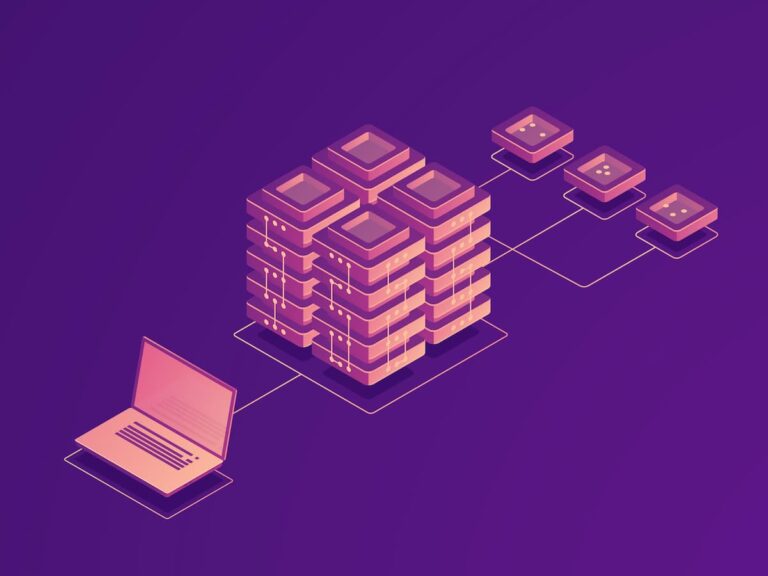Today, global economies are embracing digital payments, setting a new standard across a variety of industries. This trend suggests that digital payment adoption continues to increase. Thus, FinTech companies more often adopt emerging technologies to remain competitive and offer exceptional platform features.
Wherever money flows, risk follows. Choosing technology that is both secure and scalable is a new must to ensure a high-end user experience since the FinTech sector, which handles transactional data, is especially vulnerable to cyber threats.
So, holistic risk assessment and risk management strategy are required when selecting your technology foundation. From mobile applications to sensitive data privacy and protection measures, adopting advanced technology is key to driving your finance business towards peak efficiency and security best practices.
What is a technology stack?
Have you ever wondered what goes into building your favourite apps? This is nothing else than a tech stack. This collection of programming languages, frameworks, and tools each brings its own set of benefits to the table, working together to turn an app or software idea into reality.
Each component has a distinct function, working together to create exceptional products. Knowing your tech stack inside and out is invaluable, giving you the resources to build great FinTech apps.
A technology stack is composed of three main layers
Here’s a brief overview:
- Frontend (Client-side): This is the visible part of your application, the interface with which users directly interact. It’s designed using technologies such as HTML, CSS, JavaScript, and various UI frameworks. This layer is where the user experience is shaped and brought to life.
- Backend (Server-side): Operating behind the scenes, this layer is the core logic of your application. It processes and responds to frontend requests. It covers web frameworks, programming languages, server environments, and operating systems to ensure smooth operation and database management.
- Database: Serving as the storage centre, the database holds critical data such as user profiles, product information, and more. It functions as the application’s repository, maintaining and managing data efficiently.
Together, these components form the backbone of any software, enabling it to function, interact with users, and manage data effectively.
Market trends overview
Today, FinTech is the leading trend in software development, driven by how technology simplifies access to financial services and guarantees transparency. Additionally, the growing partnerships between regulatory entities and established financial institutions are the main drivers for the burgeoning financial technology software market. These collaborations use advanced technologies to offer extensive, value-added services to customers, making them available anywhere and anytime.
According to Mordor Intelligence, the Fintech Market size is estimated at USD 356.73 billion in 2025 and is expected to reach USD 686.85 billion by 2030.
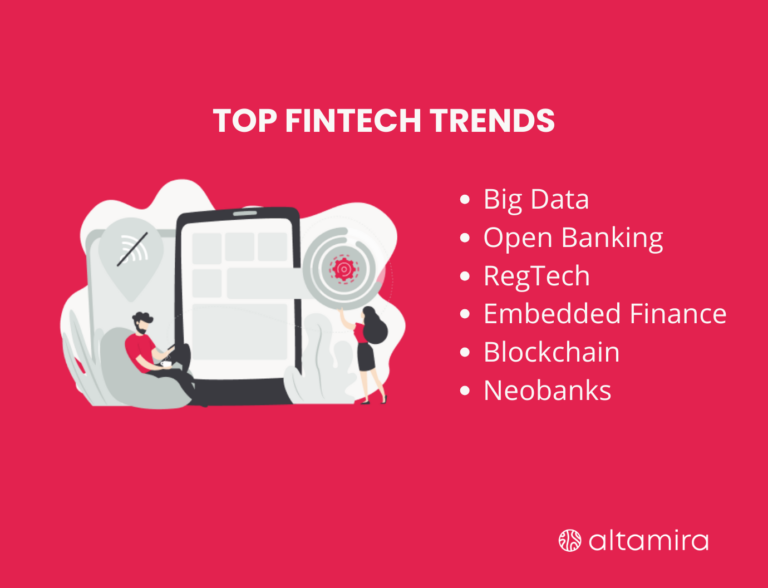
Top technologies for FinTech software development
The finance industry’s online domain is permanently under the watchful eye of cyber criminals. So, make sure you opt for the right tech stack to enable your FinTech platform to maintain the highest level of security. Let’s consider the latest trending technologies in fintech software development to better understand what tech stack is better for your business growth.
Python
Python stands out as one of the most accessible and secure programming languages for the FinTech sector. Its extensive standard library includes tools and modules for secure hashing and data encryption, enabling the secure transmission and storage of sensitive financial data. Additionally, Python’s ability to scale with the use of frameworks like Django and Flask allows FinTech companies to handle increased loads without compromising performance, making it suitable for high-traffic FinTech services.
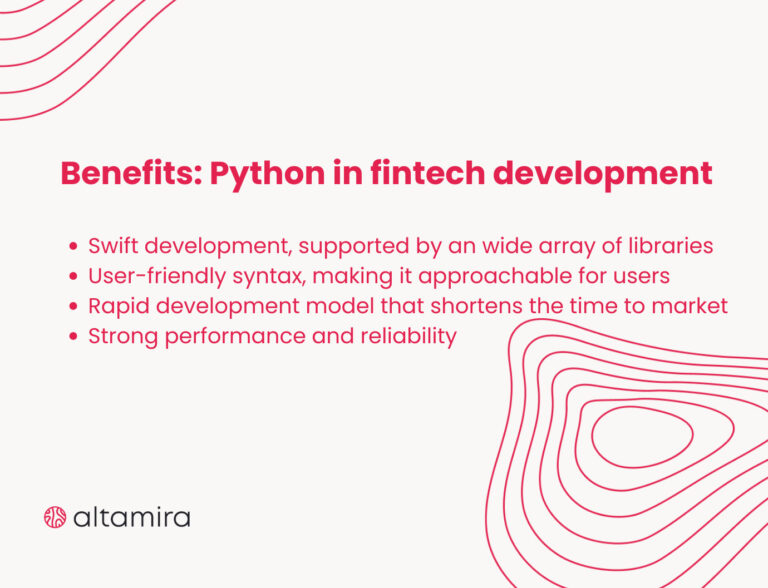
Use cases of Python in FinTech development
Python is highly recognized for its strong mathematical calculations, providing powerful tools for statistics, big data analytics, and predictive analysis. Its usage in FinTech covers a range of essential functions, such as:
- Data Visualisation and Analysis
- Stock Trading Platforms
- Cryptocurrency
- Traditional Banking Software
- Python Libraries and Frameworks
Java
Java is a top selection for FinTech development due to its adaptability. Its focus on security and the ability to scale effectively positions it as a prime option for crafting FinTech solutions. Hiring Java developers can streamline the delivery of FinTech apps and websites specifically designed for the banking and finance sectors.
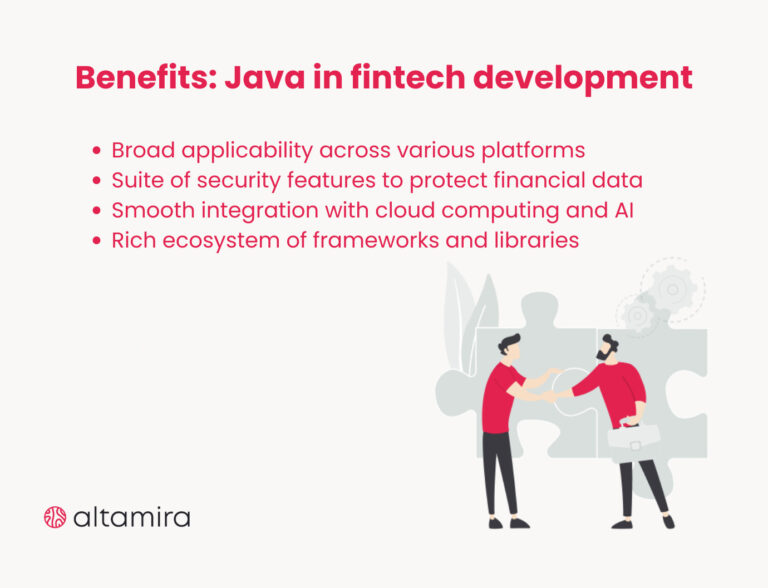
Use cases of Java in FinTech development
Java is renowned for its capacity to handle high-volume data efficiently across various systems. Its application is widespread, catering to a diverse range of FinTech solutions:
- Payment Apps
- Banking Apps
- P2P Lending Apps
- Investment Platforms
C++
If you’re searching for a technology foundation for FinTech development, C++ stands out as a prime choice. It’s versatile enough to be used by both fintech startups and financial firms looking to build complex systems. C++ is favoured by numerous companies for finance-related operations due to its reliability and security. Moreover, C++ can design systems capable of identifying potential risks.
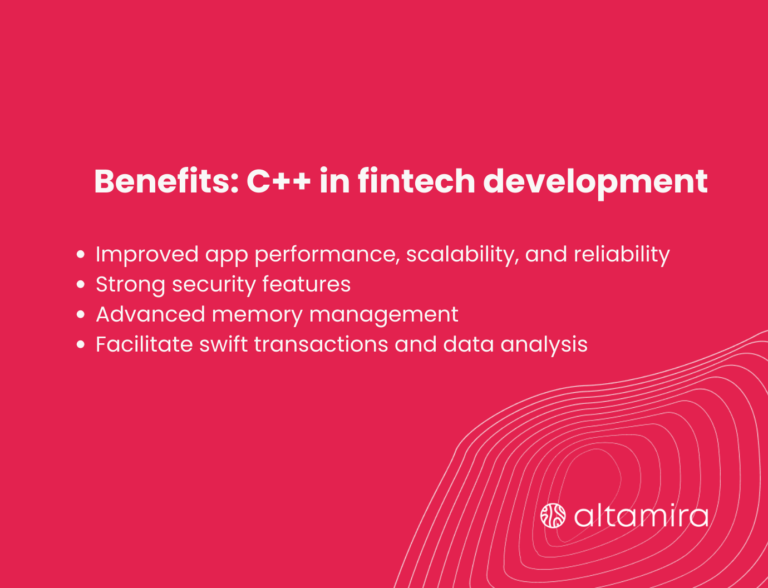
Use cases of C++ in FinTech development
C++ is a cornerstone for many FinTech firms and banks, especially when it comes to developing digital platforms. This versatile programming language enables the development of various FinTech apps and websites. In addition, it facilitates the process of maintaining real-time updates and extensive portfolio modelling.
- Banking Systems
- Trading Platforms
- C++ libraries and frameworks for FinTech development
Blockchain
Blockchain is maturing beyond its initial cryptocurrency applications, as it offers exceptional security benefits due to its decentralized nature and cryptographic hash functions. Each transaction is encrypted and linked to the previous one, creating a tamper-proof record. In FinTech, Blockchain ensures the integrity of financial transactions and prevents fraud. Blockchain’s use of smart contracts also automates and secures complex agreements without the need for external vendors, further improving security in financial operations.
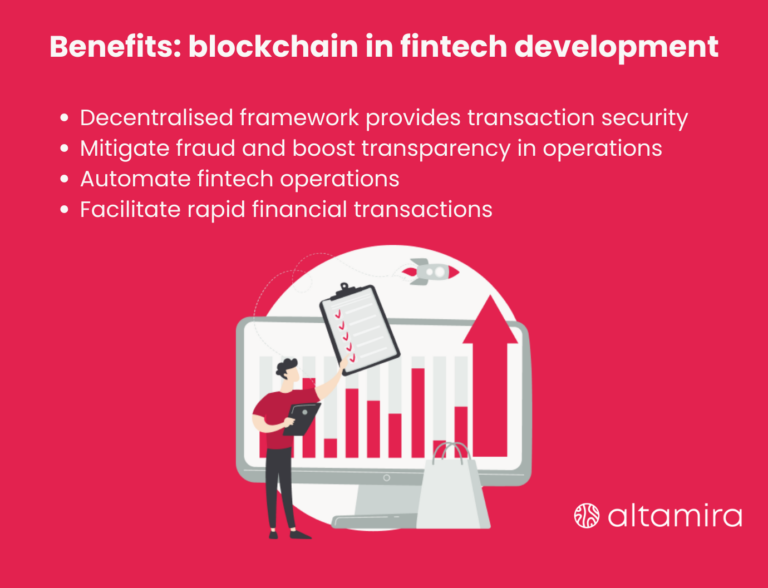
Use cases of Blockchain in the FinTech industry
Blockchain technology is a new must in FinTech areas where transparency and security are the priority. Its applications across various segments of FinTech illustrate its versatility and effectiveness.
- Ripple (leading provider of crypto solutions for businesses)
- Chainlink (cryptocurrency and technology platform that enables blockchain platforms to interact with external data securely)
- Trading Platforms
- Lending Platforms
ReactJS
React has become a foundational element in FinTech development and is celebrated for its effectiveness. Born out of Facebook, this open-source library simplifies the development workflow. Its capability to optimise data-loading operations stands out, particularly with large datasets. By adopting React, companies can acquire user interface components for FinTech apps, significantly accelerating the development timeline.
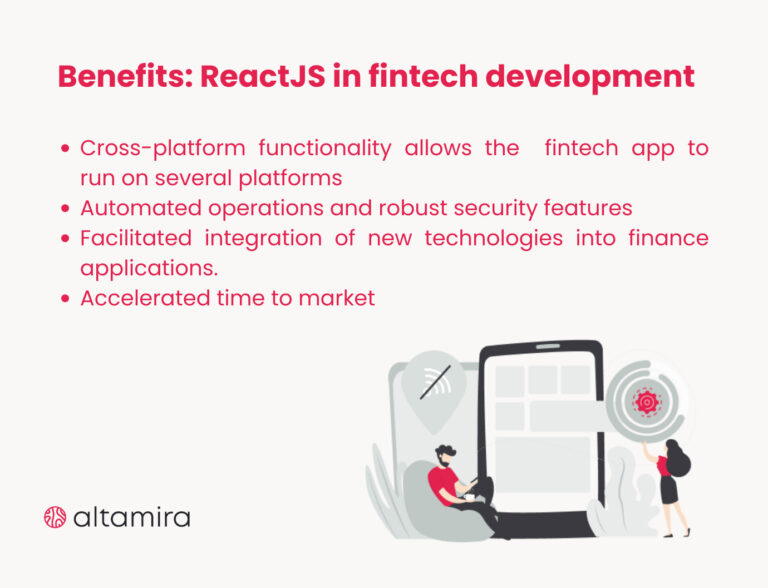
Use cases of ReactJS in the FinTech
Numerous banks across the globe opt to hire React JS developers to guarantee a high-quality user interface for their FinTech applications. ReactJS is a compelling option for diverse monetary-related requirements within the FinTech. Notably, ReactJS facilitates data updates, rendering it particularly well-suited for the intricacies of the finance industry.
- Mobile apps
- Investment and trading platforms
- UX Personalisation
- Third-party integration
Ruby
Ruby is highly favoured by many financial businesses as it streamlines the management of complex projects, allowing for the development of strong dashboards without a significant investment of time. Especially among organisations prioritising payments, Ruby’s capability to handle real-time updates and manage data makes it a popular choice, underscoring its benefits.
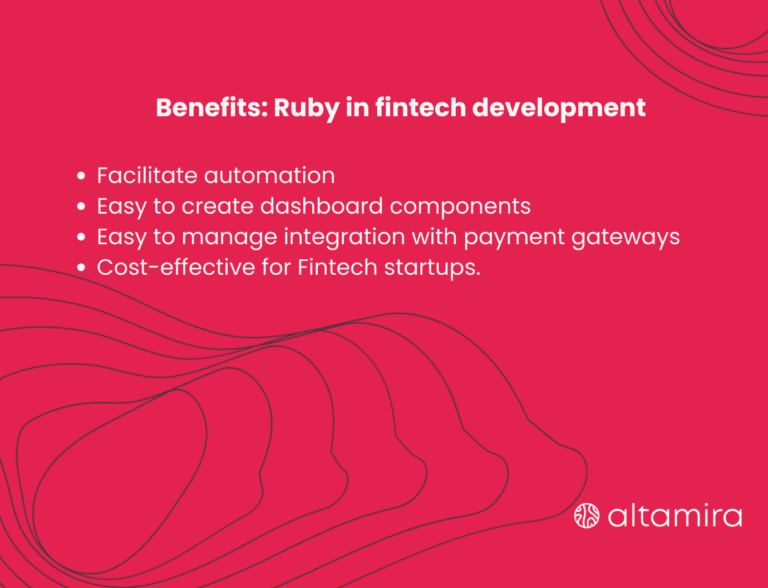
Use cases of Ruby on Rails in the FinTech development
Scaling to accommodate high traffic volumes becomes effortless with adding more servers, while the framework’s flexibility allows for the seamless integration of multiple instances as required. Hence, Ruby on Rails emerges as an excellent choice for managing sudden spikes in traffic.
- B2B finance software
- Finance management solutions
- Digital payment systems
Kotlin
As you consider app development for your FinTech project, Kotlin deserves close attention. It’s a go-to technology for many companies involved in developing finance-related platforms. Kotlin’s adaptability is particularly valuable for creating sophisticated banking applications, dramatically reducing the time to launch. Known for delivering a smooth user experience and strong security measures, Kotlin is a leading force in FinTech software development.
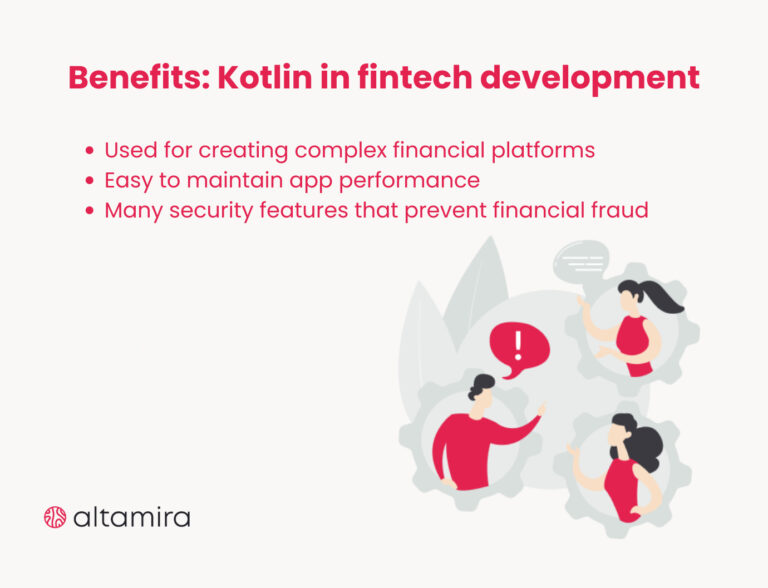
Use cases of Kotlin in the FinTech development
Kotlin is the undisputed leader in Android development, yet its utility stretches far beyond just web projects. Packed with reliable security features, Kotlin positions itself as a complex solution for developing feature-rich applications and websites.
- Banking educational solution
- Android app development
- Full-stack finance website development
Top tips for choosing your technology stack
Embarking into web development can be compared to wandering through a maze, where each turn maps the journey’s success. Choosing the right tech stack for FinTech software development must be precise, reliable, and apt for the anticipated outcome. Here are key pointers to guide your selection.
Defining project scope
Choosing the right technology stack depends entirely on understanding your project’s scope, complexity, and specific features. For larger, more complex projects, it’s wise to go for a sophisticated tech stack to meet the demands efficiently.
Scalability requirements
As your project grows, it’s essential to have a technology stack that can scale with it. Imagine moving to a larger playground that’s fully equipped to handle more activities and welcome more users without any hitches. Ensuring your tech stack is capable of this scalability is key to supporting your project’s development and expansion smoothly.
Technology & Team Expertise
Choose a tech stack that perfectly fits your team’s skills, enabling smooth operation and simplifying maintenance after deployment. The right tech stack can significantly improve the development process and the long-term management of your project.
Time to Market
It should glide through the development phase, swiftly overcoming challenges and crossing the finish line in style, all while adhering to deadlines. Moreover, the tech stack you select should not only speed up the development process but also maintain the quality of the project, ensuring it’s completed within the anticipated time frame.
Security Requirements
Suppose your app is responsible for protecting valuable assets such as user data. In that case, it’s crucial to be meticulous in choosing a tech stack with a strong emphasis on advanced security protocols to ensure the integrity and confidentiality of your prized assets. Prioritising security in your tech selection will help shield your digital assets from potential threats.
Maintenance
The journey of app development doesn’t end at launch; it requires continuous care and attention. Choosing a low-maintenance tech stack is essential for facilitating effortless updates and routine maintenance, ensuring your project remains “healthy.” This approach will help you keep your application in top condition, adapting and growing over time.
Development Cost
Take into account the total development, covering both the immediate expenses and the long-term financial impact. This includes assessing the advantages of leveraging open-source solutions. By navigating towards open-source tools, you can manage your expenses efficiently, paving the way for your project to evolve into a successful product.
Final thoughts
Selecting a technology stack in 2025 implies finding a balance between meeting current needs and aligning future ambitions. Each layer, from the user interface to the backend infrastructure, plays an important role in the overall project delivery. Your main goal is to create a consistent technology unit that boosts web performance, streamlines developer productivity and provides a superior user experience.
While navigating through the myriad of technologies might seem overwhelming, equipped with the right knowledge, the journey becomes smoother. Remember that the optimal technology stack is one that matches your project’s requirements, budget, and long-term objectives. Whether creating a simple landing page or a complex e-commerce platform, the technology stack you select now is the cornerstone of your web application’s future success.
How we can assist you?
At Altamira, we provide solutions that make a tangible impact on our client’s rapid growth and success in the digital landscape. With domain knowledge across all aspects of product and technology development, we believe that cost-efficiency doesn’t have to compromise quality, so we are driven to deliver the best every single time.
We specialise in:
- Expert consulting and technical process auditing to improve the velocity and efficiency of software development
- Vendor transfer management process
- Mobile and web product development and end-to-end delivery
- Artificial Intelligence and Machine Learning development and consulting
- Fast and efficient team augmentation, whether in-house, outsourced, or distributed
We use cutting-edge technology to make sure your software meets your organisation’s specific needs by:
- Choosing a consistent software stack for your custom application
- Tailoring the tech stacks to provide unique advantages for your software
Contact us to learn more about the right tools. With our team on your end, you can create innovative solutions for your business challenges.


